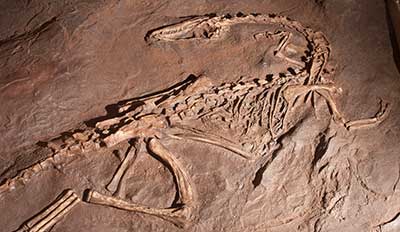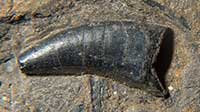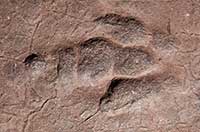Coelophysis
(SEE-loe-FIE-sis)
| Quick Facts | |
|---|---|
| Name Meaning: | Hollow Form |
| Distribution: | South Western and Eastern U.S. |
| Time Period: | Late Triassic, 208-200 Ma |
| Length: | 9 ft (2.8 m) |
| Weight: | 100 lb (45 kg) |
| Diet: | Fish, small lizards |
| Linnaean Classification | |
| Kingdom: | Animalia |
| Phylum: | Chordata |
| Class: | Reptilia |
| Superorder: | Dinosauria |
| Order: | Saurischia |
| Suborder: | Theropoda |
| Family: | Coelophysidae |
| Genus: | Coelophysis |
| Cladistic Classification | |
| |

History
 |
| Coelophysis tooth. |
 |
| Grallator track made by a dinosaur such as the Coelophysis. |
Description
The Coelophysis was a small, lightly built dinosaur, weighing approximately 100 pounds. It receives its name, "Hollow Form," from the hollow nature in its bones and skull, similar to birds, which allowed it to travel with speed. It had a long body, a narrow pointed head, and small pointed teeth. Its arms had three fingers, and the legs each bore three toes. It would have had large eyes for good eyesight. Evidence shows two different types of Coelophysis, robust and gracile, which probably represent male and female. Its long tail was curiously constructed with an interlocking structure of the vertebrae allowing the tail to move only from side to side and preventing vertical movement. This may have helped it while moving at great speeds as a rudder.Lifestyle
The Coelophysis was a predator, preying on small animals, though they may have hunted larger prey in packs. Although no concrete evidence suggests that they hunted in packs the mass find in New Mexico hints that this was possible. Discovery of baby Coelophysis in the abdominal region of the adult suggests that they may have cannibalized their own young. However, this may have been an adult fossilized on top of a younger dinosaur. No other evidence for cannibalism currently exists.
ScienceViews Writer: Jason Hamilton.
Copyright © 2005-2010 Calvin & Rosanna Hamilton. All rights reserved.